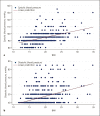Obesity, Blood Pressure, and Intraocular Pressure: A Cross-Sectional Study in Italian Children
- PMID: 33794545
- PMCID: PMC8138192
- DOI: 10.1159/000514096
Obesity, Blood Pressure, and Intraocular Pressure: A Cross-Sectional Study in Italian Children
Abstract
Introduction: Several studies in the adult population have shown that obesity is an independent risk factor for elevated intraocular pressure (IOP), whereas data in the paediatric population are sparse and controversial. The purpose of the present study is to investigate the relationship between body mass index (BMI), blood pressure (BP), and IOP in healthy school children.
Methods: The survey was conducted among a random sample of 8-year-old Italian students. Data were collected on their health status and behaviours related to obesity (physical activity, food and drinking habits, etc.). Physical examinations, conducted at school, included measurements of height, weight, BP, and IOP.
Results: Five hundred and seventy-six subjects were recruited (92.8% response rate); 42.4% were overweight or obese, 58.9% consumed inadequate daily servings of fruit and vegetables, and 87.5% were involved in sedentary activities. Elevated BP/hypertension (HTN) affected 3.6% and high IOP was revealed in 12.5% of the children. In the multivariate analysis, elevated BP/HTN was the only significant determinant of ocular HTN (OR 5.36, 95% CI 1.95-14.73, p = 0.001).
Conclusions: Our results show that high IOP affects 12.5% of 8-year-old school children and appears to be associated with high BP related to a high BMI.
Keywords: Blood pressure; Childhood obesity; Intraocular pressure; Myopia; Overweight; Refractive error.
© 2021 The Author(s) Published by S. Karger AG, Basel.
Conflict of interest statement
The authors have no conflicts of interest to declare.
Figures
References
-
- Pileggi C, Carbone V, Nobile CG, Pavia M. Blood pressure and related cardiovascular disease risk factors in 6-18 year-old students in Italy. J Paediatr Child Health. 2005 Jul;41((7)):347–52. - PubMed
-
- Wijnhoven TM, van Raaij JM, Spinelli A, Rito AI, Hovengen R, Kunesova M, et al. WHO European Childhood Obesity Surveillance Initiative 2008: weight, height and body mass index in 6-9-year-old children. Pediatr Obes. 2013 Apr;8((2)):79–97. - PubMed
-
- Abarca-Gómez L, Abdeen ZA, Hamid ZA, Abu-Rmeileh NM, Acosta-Cazares B, Acuin C, et al. NCD Risk Factor Collaboration (NCD-RisC) Worldwide trends in body-mass index, underweight, overweight, and obesity from 1975 to 2016: a pooled analysis of 2416 population-based measurement studies in 128·9 million children, adolescents, and adults. Lancet. 2017 Dec;390((10113)):2627–42. - PMC - PubMed
-
- Geloneck MM, Crowell EL, Wilson EB, Synder BE, Chuang AZ, Baker LA, et al. Correlation between intraocular pressure and body mass index in the seated and supine positions. J Glaucoma. 2015 Feb;24((2)):130–4. - PubMed
MeSH terms
LinkOut - more resources
Full Text Sources
Other Literature Sources
Medical



